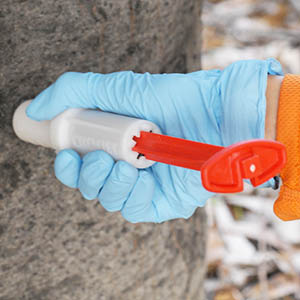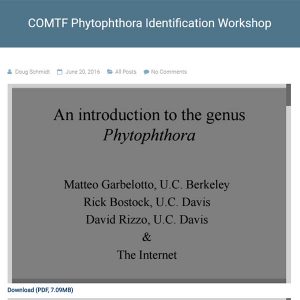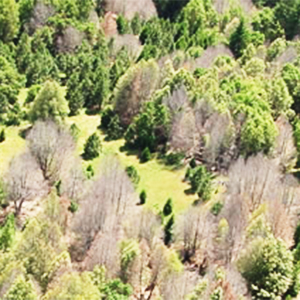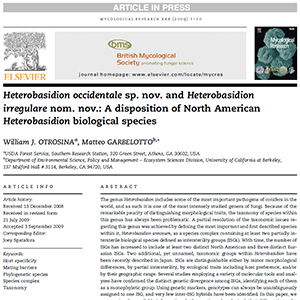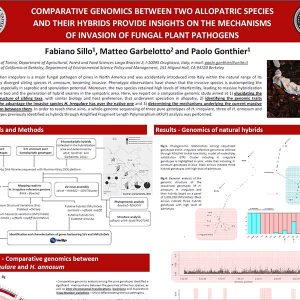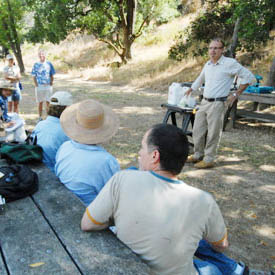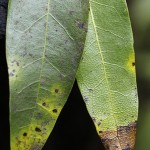 SOD is an exotic disease caused by the microscopic pathogen Phytophthora ramorum, estimated to have been introduced into California 20-25 years ago from unknown region of the world.
SOD is an exotic disease caused by the microscopic pathogen Phytophthora ramorum, estimated to have been introduced into California 20-25 years ago from unknown region of the world.- P. ramorum was unwittingly introduced into California’s natural landscape when infected ornamental plants, such as Rhododendrons and Camellias (which carry the disease), were outplanted into the environment. On many ornamental plants, as well as many native forest plants (including California bay laurels and tanoak), the pathogen causes a disease called ramorum blight. Ramorum blight is a foliar disease that often supports pathogen sporulation and spread, as the spores build up on the leaves and twigs of these hosts which can then be transferred to nearby oaks and tanoaks, causing sudden oak death. Ramorum blight is rarely lethal.
- In California, foliar infections on Bay Laurel leaves are mostly responsible for spreading the disease. Oaks and tanoaks are infected when in proximity of bay laurels. Oaks only get a stem infection; tanoaks can develop both stem
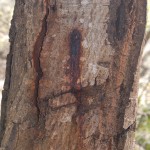 and a foliar infection. Tanoaks are the only tree species that can spread the the disease and die from it as well. When P. ramorum infects oaks and tanoaks it destroys the cambium under the bark and effectively girdles the tree. Girdled trees are doomed, but can survive for 1 to 5+ years thanks to stored resources and their natural tolerance to drought.
and a foliar infection. Tanoaks are the only tree species that can spread the the disease and die from it as well. When P. ramorum infects oaks and tanoaks it destroys the cambium under the bark and effectively girdles the tree. Girdled trees are doomed, but can survive for 1 to 5+ years thanks to stored resources and their natural tolerance to drought. - Besides Tanoaks, California Coast Live Oak, Black Oak, Shreve’s Oak, and Canyon Live Oak are known to be infected by P. ramorum. Oaks are not infectious in nature and do not spread the disease further, but oak wood may be infectious if carried to an uninfested area.
- P. ramorum can infect leaves and trunks of it’s hoasts without the need for wounds, but it does require rainfall and temperatures between 60 and 80F (25 to 27C). As a result most infections occur in the rainy season and in particular when spring temperatures rise (mid April to June).
- Yearly infection levels will depend on the presence of rainfall in the Spring; while tanoaks and bay laurels are infected yearly, oaks are normally infected only in years with abundant Spring
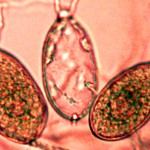 percipitation.
percipitation. - P. ramorum is dispersed aerially usually at short distances 100 yrds (100m) or less, but occasionally up to 1-2 miles (1.7-3.5km).
- Infectious airborne microscopic structures known as sporangia are produced during rain events on plant surfaces, primarily leaves, and can also accumulate in soil and stream water.
- Besides the natural spread of the pathogen, movement of infected plants or plant parts, soil, and water may lead to new infestations. Soil and plant material on tools and equipment may vector the disease.
- During dry periods, the pathogen survives within infected plant tissues, and by producing a thick walled resting structure called a chlamydospores. As a result SOD remains persistent in any site, but oak infection varies as it requires high infection levels of bay laurels.
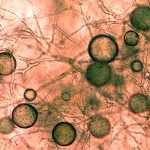
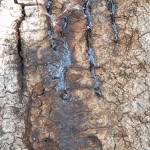
What is Sudden Oak Death?









